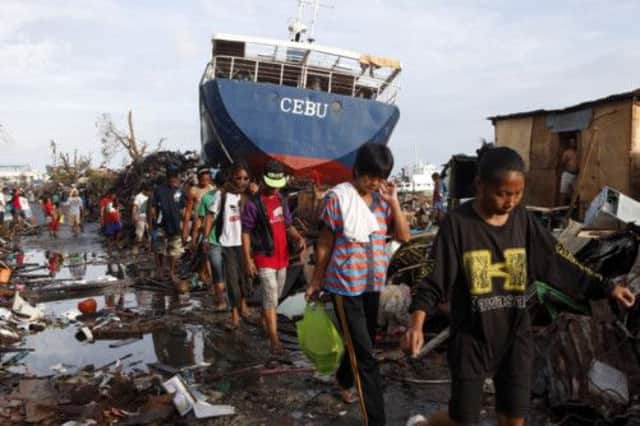Typhoon: Philippines starts to pick up the pieces


Officials now say more than 5,000 people died, on Leyte, Samar and the nearby islands in the Eastern Visayas region. Interior minister Mar Roxas confirmed a toll of 4,919 dead while civil defence chief Eduardo del Rosario said another 290 people had been killed in other parts of the central Philippines.
Leyte was particularly badly affected, with its main town, Tacloban, being flattened two weeks ago by fierce winds and tsunami-like storm surges from Haiyan, known locally as Yolanda. Mr Del Rosario said 1,611 people were still missing.
Advertisement
Hide AdAdvertisement
Hide Ad“That is the sad record of Yolanda’s passage through our country,” Mr Roxas said. But he added: “The worst is over.”
He likened the region to a patient that has been moved out of the emergency room into an intensive care unit.
“We have overcome the most difficult part,” he said. “In the first week we can say we were in the emergency room … this second week we are now in the ICU, still critical but stabilised.”
He said 1,725 people had been killed in Tacloban. “I believe this number in Tacloban city is not yet final,” he added.
Most of the bodies have been buried in mass graves, many of them unidentified, he said.
“It is possible that some of the missing are among the unidentified,” he said.
Journalists in Tacloban say the stench of death from piles of debris, upturned vehicles and remnants of what once were homes indicates that bodies remain trapped underneath.
Mr Roxas said the situation was stabilising, with major roads on Samar and Leyte cleared of debris and some banks, shops and petrol stations now open.
Advertisement
Hide AdAdvertisement
Hide AdMore troops and police have been brought to the region from other parts of the country to keep the peace. The airport in Tacloban, the regional hub, and its port are operating. “There is no more looting,” he said. “We are now heading to recovery and reconstruction.”
Haiyan hit the eastern seaboard of the Philippines on 8 November and quickly moved across its central islands, packing winds of 186mph – the fourth strongest storm ever recorded – with a storm surge of 20ft. Eyewitnesses reported waves as high as coconut trees, which grow to more than 50ft.
Even though authorities evacuated about 800,000 people ahead of the typhoon, the death toll was high because many evacuation centres – schools, churches and government buildings – could not withstand the winds and water. Officials said people who sought shelter in the buildings drowned or were swept away.
At least 24 governments quickly sent aid, with the British public giving more than £50 million to the Disasters Emergency Committee. The US sent an armada of naval vessels. Bottlenecks, including roads blocked by debris, damaged vehicles and a lack of personnel, held up the distribution of relief supplies in the first week.
US marines cleared the Tacloban airport runway, allowing the delivery by air of aid to the city which became the relief centre for the region.
Mr Roxas said more than 1.1 million food packs have been delivered.
“Our mission is to deliver relief and food supplies to all the towns with 100,000 food packs every day,” he said.
Each pack contains enough rice, noodles, canned goods and coffee for a family for two days.